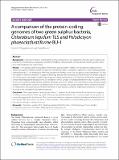Files in this item
A comparison of the protein-coding genomes of two green sulphur bacteria, Chlorobium tepidum TLS and Pelodictyon phaeoclathratiforme BU-1
Item metadata
| dc.contributor.author | Wregglesworth, Kristin | |
| dc.contributor.author | Barker, Daniel | |
| dc.date.accessioned | 2015-10-14T16:10:02Z | |
| dc.date.available | 2015-10-14T16:10:02Z | |
| dc.date.issued | 2015-10-14 | |
| dc.identifier | 220802549 | |
| dc.identifier | d733ec61-8833-4cfa-8571-ecd46fb89b41 | |
| dc.identifier | 84944048700 | |
| dc.identifier.citation | Wregglesworth , K & Barker , D 2015 , ' A comparison of the protein-coding genomes of two green sulphur bacteria, Chlorobium tepidum TLS and Pelodictyon phaeoclathratiforme BU-1 ' , BMC Research Notes , vol. 8 , 565 . https://doi.org/10.1186/s13104-015-1535-8 | en |
| dc.identifier.issn | 1756-0500 | |
| dc.identifier.uri | https://hdl.handle.net/10023/7652 | |
| dc.description | Date of Acceptance: 30/09/2015 | en |
| dc.description.abstract | Background: Chlorobium tepidum and Pelodictyon phaeoclathratiforme are organisms within the green sulphur bacteria family, Chlorobiaceae, occupying very different habitats. It has recently been proposed that the genera Chlorobium and Pelodictyon are synonymous. Findings: To investigate generic boundaries for the two species, protein families were predicted computationally based on sequence similarity across the genome-wide protein sets of Chlorobium tepidum TLS and Pelodictyon phaeoclathratiforme BU-1. The distribution of the resulting protein families across the two species was summarized. The largest number of families exhibited 1:1 putative orthology between the two species (1468 families). Of families unique to one of the species, the largest number was unique to P. phaeoclathratiforme (113 families), of which the largest family contained pentapeptide repeat proteins (16 proteins). Families unique to P. phaeoclathratiforme also included a family of gas vesicle synthesis proteins (four proteins). Although only 7 families were identified as containing paralogous proteins in both species (with two or more proteins in each species), this group included families of major biochemical importance. One such family, with three members in each species, contained magnesium chelatase, an enzyme involved in the chlorophyll biosynthetic pathway. Conclusion: The unique protein family groups in both C. tepidum and P. phaeoclathratiforme mirror the occupancy of different environments, while key shared family groups provide evidence for a common origin for the species, as previously suggested in the literature. The current study only uses sequence similarity-based protein families for the two species. This, alone, does not permit a firm conclusion to be drawn on the taxonomic question, of whether the two species belong in one genus or two. | |
| dc.format.extent | 5 | |
| dc.format.extent | 857176 | |
| dc.language.iso | eng | |
| dc.relation.ispartof | BMC Research Notes | en |
| dc.rights | © 2015 Wreggelsworth and Barker. This article is distributed under the terms of the Creative Commons Attribution 4.0 International License (http://creativecommons.org/licenses/by/4.0/), which permits unrestricted use, distribution, and reproduction in any medium, provided you give appropriate credit to the original author(s) and the source, provide a link to the Creative Commons license, and indicate if changes were made. The Creative Commons Public Domain Dedication waiver (http://creativecommons.org/publicdomain/zero/1.0/) applies to the data made available in this article, unless otherwise stated. | en |
| dc.subject | Chlorobium tepidum TLS | en |
| dc.subject | Pelodictyon phaeoclathratiforme BU-1 | en |
| dc.subject | Chlorobiaceae | en |
| dc.subject | Protein families | en |
| dc.subject | Comparative genomics | en |
| dc.subject | OrthoMCL | en |
| dc.subject | Ortholog | en |
| dc.subject | Paralog | en |
| dc.subject | Raspberry Pi | en |
| dc.subject | QH301 Biology | en |
| dc.subject | QA75 Electronic computers. Computer science | en |
| dc.subject.lcc | QH301 | en |
| dc.subject.lcc | QA75 | en |
| dc.title | A comparison of the protein-coding genomes of two green sulphur bacteria, Chlorobium tepidum TLS and Pelodictyon phaeoclathratiforme BU-1 | en |
| dc.type | Journal article | en |
| dc.contributor.institution | University of St Andrews.School of Biology | en |
| dc.identifier.doi | 10.1186/s13104-015-1535-8 | |
| dc.description.status | Peer reviewed | en |
| dc.identifier.url | http://www.biomedcentral.com/1756-0500/8/565#sec5 | en |
This item appears in the following Collection(s)
Items in the St Andrews Research Repository are protected by copyright, with all rights reserved, unless otherwise indicated.

